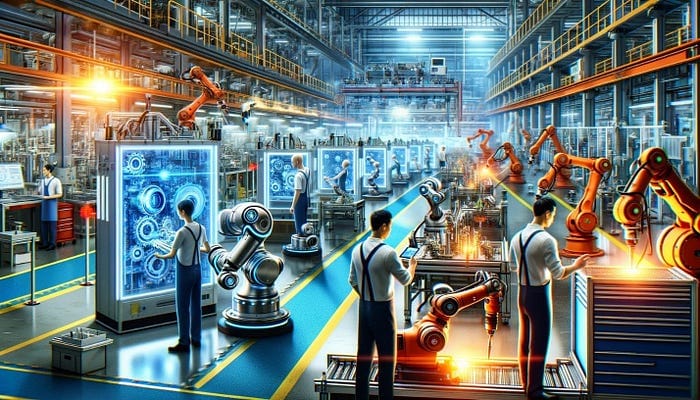The Impact of AI on the Fourth Industrial Revolution

In an age where the digital and physical realms increasingly converge, the question “Will AI take my job?” has transcended mere speculative curiosity to become one of the most pressing inquiries of our time. This concern, echoed across countless internet searches, captures the essence of the human response to the rapid technological advancements characterizing the fourth industrial revolution. This short essay explores the multifaceted dimensions of AI and automation’s impact on employment, drawing parallels with historical and technical disruptions to offer insights into the future of work in an AI-automated world.
Historically, technological innovation has been a double-edged sword, simultaneously dismantling traditional industries while laying the foundation for new areas of human endeavor. The introduction of telephony, for instance, marked the decline of horse messengers, signaling the end of an era while ushering in a new age of communication. Similarly, the resurgence of vinyl records in a digital age is a poignant reminder of technology’s cyclical impact, where old and new coexist, each with its unique value proposition. The gradual obsolescence of film photography further exemplifies this transition, highlighting the shift towards digital immediacy over analog warmth. These historical precedents underscore a fundamental truth: change, though often met with resistance, is an inevitable driver of societal evolution.
Standing at the so-called fourth industrial revolution, we must recognize that automation and machine learning are not merely precursors of displacement but catalysts for transformation. The anxiety surrounding the potential loss of jobs to AI and robots mirrors the apprehension faced by previous generations. Yet, history teaches us that such technological shifts invariably give rise to new opportunities. This revolution lies in its ability to enhance productivity, efficiency, safety, and environmental sustainability, thereby redefining the work landscape.
However, the transition to an automated economy is not without its challenges. The displacement of workers from traditional roles necessitates a robust response from policymakers and educational institutions to ensure a smooth transition. This involves reimagining education and training programs to equip the workforce with the skills required in an increasingly automated world. Furthermore, it calls for reevaluating societal values and the metrics we use to measure success and fulfillment in work.
The fear that robots will usurp human jobs overlooks the essence of what it means to be human. Creativity, empathy, and the capacity for complex problem-solving are uniquely human traits that machines are far from replicating. Thus, while automation may transform the nature of some work, it also underscores the value of distinctly human capabilities. The future of work, therefore, lies not in a dystopian vision of widespread obsolescence but in a synergistic relationship between humans and machines, where each complements the strengths of the other.
“Will AI and robots take my job?” reflects the anxieties and opportunities of the fourth industrial revolution. While automation will inevitably lead to the displacement of specific jobs, it also paves the way for new industries and roles that capitalize on human ingenuity and creativity. Embracing this change requires a proactive approach to education, training, and policy, ensuring society can navigate the complexities of an automated future. Moving forward, it might be good to view technological advancement not as a threat but as a companion in our collective journey toward a more efficient, safe, and sustainable world.
In some upcoming posts, I’ll discuss two examples of this phenomenon: the trucking industry and almost everybody’s favorite — pizza!
Join Us Towards a Greater Understanding of AI
I hope you found insights and value in this post. If so, I invite you to become a more integral part of our community. By following us and sharing our content, you help spread awareness and foster a more informed and thoughtful conversation about the future of AI. Your voice matters, and I’m eager to hear your thoughts, questions, and suggestions on topics you’re curious about or wish to delve deeper into. Together, we can demystify AI, making it accessible and engaging for everyone. Let’s continue this journey towards a better understanding of AI. Please share your thoughts with me via email: marty@bearnetai.com, and don’t forget to follow and share BearNetAI with others who might also benefit. Your support makes all the difference.
Thank you for being a part of this fascinating journey.
BearNetAI. From Bytes to Insights. AI Simplified.
Categories: Technology, Employment and Labor, Economics, Sociology, Future Studies, Environmental Sustainability
The following sources are cited as references used in research for this BLOG post:
The Second Machine Age: Work, Progress, and Prosperity in a Time of Brilliant Technologies by Erik Brynjolfsson and Andrew McAfee.
Rise of the Robots: Technology and the Threat of a Jobless Future by Martin Ford.
Humans Need Not Apply: A Guide to Wealth and Work in the Age of Artificial Intelligence by Jerry Kaplan.
The Future of Work: Robots, AI, and Automation by Darrell M. West.
The Fourth Industrial Revolution by Klaus Schwab.
Learning by Doing: The Real Connection between Innovation, Wages, and Wealth by James Bessen.
The Industries of the Future by Alec Ross.
© 2024 BearNetAI LLC